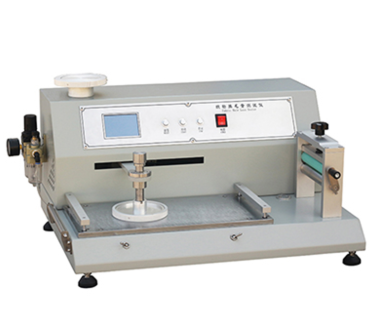
Fabric Fiber Shedding Degree Tester (Friction Method): Quantifying Linting for Q
2025/06/23
The Fabric Fiber Shedding Degree Tester (Friction Method) is an advanced instrument designed to accurately assess the tendency of textile fabrics to shed fibers, commonly known as linting. This is a critical quality parameter for manufacturers, researchers, and testing laboratories, as excessive fiber shedding can impact product aesthetics, performance, and consumer satisfaction. By simulating real-world friction, the tester provides a reliable and quantifiable measure of fiber loss.

Precision Testing Principle: How it Works
The testing process is straightforward and highly repeatable. A fabric specimen is securely mounted on a dedicated holder. A wet abrasive material, attached to a friction head, then performs a precise series of reciprocating movements across the specimen's surface under a controlled load and for a specified number of cycles.
Following the friction cycles, the abrasive is examined. The degree of fibers adhered to the abrasive is then visually compared against a set of standardized samples. This comparative analysis allows for a precise rating of the fiber shedding, providing an objective measure of the fabric's linting propensity. This method is indispensable for:
Textile Factories: Ensuring consistent product quality and minimizing customer complaints related to linting.
Scientific Research Institutes: Investigating material properties and developing new, low-linting fabrics.
Colleges and Universities: Educating future textile professionals on material testing and quality control.
Import and Export Commodity Inspection Agencies: Verifying compliance with international quality standards.
Provincial and Municipal Textile Testing Centers: Providing essential testing services for the local textile industry.
Key Features for Enhanced Usability and Accuracy
This tester is engineered with user convenience and testing precision in mind, incorporating several innovative features:
Intuitive Touch Screen Controller: Offers precise control over test parameters, allowing users to effortlessly set the desired number of friction cycles.
Redundant Mechanical Buttons: For added operational flexibility and reliability, essential functions are also accessible via backup mechanical buttons, ensuring seamless operation even in demanding environments.
Pneumatic Specimen Holder: Facilitates quick and easy installation and removal of fabric specimens, significantly improving testing efficiency.
Integrated Calender for Abrasive Moisture Control: Ensures optimal testing conditions by precisely adjusting the moisture content and roll-off rate of the abrasive material, leading to more consistent and accurate results.
Full Compliance with GB/T 40270 - 2021 (Appendix A): Guarantees that all tests performed with this instrument meet stringent national standards, providing credible and internationally recognized results.
Main Technical Specifications
The Fabric Fiber Shedding Degree Tester is built to deliver high performance and accuracy, as evidenced by its robust technical specifications:
Friction Head Stroke: (200±2) mm – Ensures consistent and reproducible friction across the specimen.
Reciprocating Speed: 30 times/min – Optimized for simulating real-world abrasive wear.
Circular Friction Head Diameter: (90±1) mm – Provides a standardized contact area for testing.
Fixed Clamp Ring Dimensions: Outer diameter: (120±0.5) mm, Inner diameter: (90±0.5) mm – Securely holds the friction head in place.
Test Washer Diameter: (113±0.5) mm – Critical for consistent abrasive application.
Foam Plastic Washer: Diameter 105 mm, thickness 8 mm, unit area mass approximately 270 g/m² – Ensures proper cushioning and contact during testing.
Total Friction Load: (595±7) g – Applies consistent pressure for accurate fiber shedding assessment.
Sandpaper: 600-grit aluminum oxide water-washable sandpaper – Specifies the exact abrasive material for standardized testing.
Power Supply: AC 220V, 50Hz – Standard power requirements for most laboratory settings.
By providing a precise, standardized, and user-friendly method for evaluating fiber shedding, this instrument is an invaluable asset for anyone involved in the production, research, or quality control of textile products. Interested in learning more about how this tester can enhance your quality assurance processes?
Previous: Leather Vamp Flexing Extensibility Testing Machine
N e x t : Automatic Down Filling Tester: Precision Measurement for Down & Feather Quality



